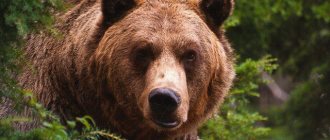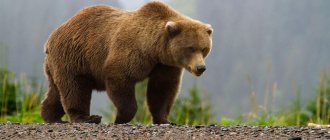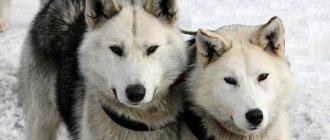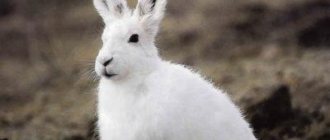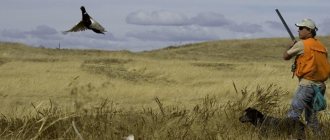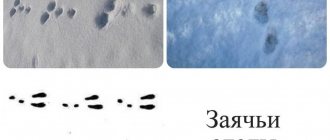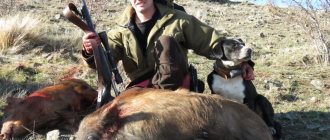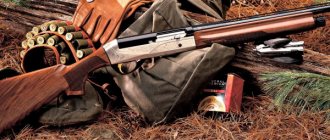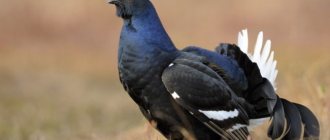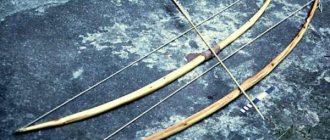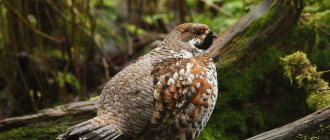Bear hunting is the most dangerous and most prestigious hunt in our country, which always leaves many vivid impressions. The bear is the most attractive and desirable trophy, which is very difficult to obtain even for an experienced hunter. When meeting a bear, everything is decided by the hunter’s fortitude, courage, composure and accuracy.
Successful bear hunting depends on good planning, careful preparation and the correct hunting method. Let's talk about this in more detail.
About the bear
Bear hunting is a very difficult task; in order to successfully hunt this smart and strong animal you need to know as much as possible about it.
The bear is the largest predatory animal in our forests; the average weight of a bear is about 200 kg. Larger specimens are also found: in Kamchatka there are male bears weighing up to 400 kg, and even bears weighing 600 kg are reported.
The bear looks clumsy in appearance, but this impression is deceptive; it can run fast, reaching a speed of 50 km/h, which is comparable to the speed of a horse or elk. The bear is capable of making long jumps, swims well, and climbs trees well.
The bear has great physical strength; with one blow of his paw he can break the back of a wild boar or elk.
Each bear, both male and female, has its own area, which the bears mark with scent marks and “tears,” special scratches left by their claws on trees. By looking at the scratches you can determine the size of the bear that left them.
The bear has a well-developed sense of smell and hearing, but the bear's vision is much less developed.
The bear is active throughout the day, but its peak activity period is morning and evening.
From October to March, the bear hibernates, lying down in a den for this purpose. A bear sleeps lightly; if the bear is disturbed or its reserves of subcutaneous fat run out, the bear may leave the den, turning into a connecting rod. The connecting rods are very dangerous; due to hunger, they attack all living things, even humans. Connecting rods, as a rule, do not survive until spring.
Previously, bear hunting in a den was allowed, but now it is prohibited by law.
The mating season for bears begins in May-June, depending on the region. The cubs appear in the mother bear's den, most often in the first half of January. A mother bear with her cubs poses the greatest danger to humans, as she protects her offspring to the death; a chance meeting with her can become deadly.
Bear hunting is permitted from April 1 to May 31 and from August 1 to November 30.
Rules for hunting in a den
- It is necessary to shoot at a bear from the shortest possible distance in order to increase the chances of quickly defeating the animal.
- All participants in the hunt must discuss the conditions and responsibilities of each in advance in order to avoid misunderstandings and injuries during the hunt.
- When shooting at a bear, remember the dog that is nearby.
- You need to approach a shot bear carefully, keeping your finger on the cocked trigger, and preferably after a control shot in the cervical vertebra.
- Under no circumstances should you let a wounded bear go, as once wounded it becomes very dangerous for everyone in the area and is unpredictable.
Bear hunting on oats
Bear hunting on oats is the main way of hunting this animal in our time. Bear hunting on oats is the best hunt for a hunter hunting this animal for the first time.
Most often, bear hunting in oats is carried out by organized hunting farms, while the huntsman of the hunting farm brings the hunter to an oat field with a storage shed installed on it; the hunter’s task is reduced only to sitting in the storage shed for a couple of evenings and firing a well-aimed shot at the animal in time. In good hunting grounds, such oat fields are specially sown near the forest. Some hunters organize and conduct the entire bear hunt on oats themselves and believe that, although it is more difficult, it is much more interesting.
Although the bear is an omnivore, before a long winter hibernation the bear needs to gain a supply of fat; the bear’s survival in winter depends on this. When a bear eats oats, it quickly gains weight, which is why oat fields are so attractive to it. A good oat field located near a forest will be visited by bears from year to year and a hunter will easily find traces of a bear’s presence in it.
The bear feeds in oat fields from August to September, for about 15 days. The bear loves the stage of milky-waxy ripeness of oats. A hunter can easily notice signs that an oat field is being visited by a bear:
- The oats are sucked down rather than eaten entirely, as livestock do.
- There are often piles of bear droppings on the field.
- At the point where the animal enters the oat field, one or more “rolls” can be found, that is, a place where the bear rolls on the ground, having previously sprinkled it with urine.
- While feeding, the bear leaves an odorous trail on the field.
Before hunting, you need to thoroughly study the area adjacent to the oat field, calculate feeding routes, and determine where the bear will enter the field.
After this, a storage shed is set up. The storage shed is done as follows:
- The storage shed is built long before the start of the hunting season.
- A reliable, strong tree with a dense crown is selected. A thick crown is needed so that the storage shed is not noticeable, otherwise the bear will stop walking into the field.
- The storage shed must be located at a height of at least 5 meters. It should be remembered that a wounded bear is extremely dangerous and can easily climb trees.
- It is better to bring logs with you for the construction of a storage shed, rather than using local materials at hand.
- The storage shed can be made in the form of the simplest design: three wooden sticks (for the legs, seat and back), but it is better if it is as comfortable as possible, because sometimes you will have to wait for a bear for a long time. At a minimum, it is advisable to make a cushion for the seat and some kind of sides so as not to fall from the storage shed in the dark.
- It is best to set up a storage shed at some distance from the place where the bear enters the field. Ideally, the storage facility should allow you to view the entire field.
When hunting a bear on oats, in order for the hunt to be successful, the hunter must follow some rules:
- You need to occupy a place in the storage shed long before the bear is expected to enter the field, so that the smell of sweat emanating from you disappears. You need to climb into the storage shed quietly and carefully.
- Remember that the bear primarily relies on smell and hearing. Before hunting a bear: do not shave, do not smoke, do not drink alcohol, do not use any cosmetics or perfumes (deodorants, colognes), do not eat foods with a strong smell (onions, garlic). Clothes and shoes are thoroughly ventilated so that no odors come from them; it is even better to keep your clothes and shoes in a bag with mint and spruce branches.
- Adult bears go out to the oat field at about 20 pm, some may go out earlier, very young bears can feed even during the day.
- The shot will often have to be carried out in poor lighting conditions; it is advisable to use a night vision scope or thermal imager.
- The bear will feed in the field for about half an hour, the hunter should not rush to shoot, you need to let the animal get as close as possible and only then fire an accurate, well-aimed shot.
- When shooting from a smoothbore gun, the maximum shooting distance at a bear is 30-40 meters; when shooting from a rifle, the maximum shooting distance at a bear is up to 100 meters.
- You can shoot only if you are convinced that it is really a bear, and not livestock or, even worse, a person.
- The best killing spots for a bear are the area of the heart, which is located at the level of the folds of the front paws. Some hunters shoot the bear in the neck or under the shoulder blade. It is useless to shoot a bear in the head; the bear has a strong, cone-shaped skull; when a bullet hits it, it passes tangentially and does not cause serious damage to the animal.
- If the first shot does not put the bear in place, you need to immediately make the second, and if necessary, then subsequent ones. A wounded bear is extremely dangerous; it can run away quickly and far even with severe wounds.
- You cannot chase a wounded bear alone. It is better to look for a wounded bear the next day, in a group of hunters with dogs.
- You need to approach the carcass of a dead bear with extreme caution and only after you are convinced that the bear is really dead.
Hunting from the approach
The most difficult, but also one of the most effective methods is hunting a bear from the approach. It is chosen only by an experienced hunter, confident that:
- A chance encounter with an animal will not panic him, and he will be able to act calmly and correctly.
- He can track the beast without dogs
- He knows all the intricacies of hunting and will be able to approach the bear without giving away his presence either by sound or smell.
They get ready to hunt from the approach in advance. It should be carried out if there are many small feeding areas in the forest, which the animal visits in a chaotic manner, and it is simply not possible to “cover” all the points with storage sheds. You should prepare for a long hike and take everything you need with you. You should not follow known bear paths - this may scare away the animal.
You need to move as silently as possible. This applies not only to a quiet step: it is recommended to put all things in the backpack so that they do not ring or rustle. A spoon accidentally hitting the bowl will scare away the prey, and the frightened animal will begin to behave more carefully.
Approach hunting tactics are as follows:
- A man notices a feeding bear.
- He tries to get as close to him as possible. You should move very slowly. If the animal becomes wary (stops eating, moves its nose and ears, listens), you need to freeze.
- A shot is fired. Before you shoot, you need to make sure that the prey is clearly visible. Hasty shooting often leads to tragedy: it is quite possible that several people are hunting a bear at the same time, without knowing about each other.
Bear hunting with huskies
Bear hunting with huskies is another way to hunt this animal. Usually, two or three huskies are used for bear hunting with huskies. The best time for such a hunt is late autumn, when the bear is preparing to hibernate; at this time it becomes clumsy and it is easier for huskies to cope with it.
The hunter and his dogs walk around the places where bears feed: rich berry fields, swamps. The dogs sniff out a fresh trail of a bear and use it to find the animal. The task of the huskies is not only to find the bear, but also to keep the bear in place by barking until the hunter approaches.
When hunting with huskies, a bear is rarely immediately stopped by the dogs; the hunter determines the location of the animal by the barking of the dogs and tries to follow the dogs at some distance. When the bear gets tired, he tries to drive the dogs away by standing on his hind legs, sitting on the ground or leaning his back against a tree.
Laikas cannot cause serious harm to the bear; they attack the bear one by one, inflicting painful bites on it. It’s better when there are two or three dogs, one husky cannot effectively restrain the bear, and when there are several huskies, they coordinate their actions without giving the bear a moment’s respite.
The dogs try to keep him in this state until the hunter approaches. While the bear is busy with huskies and not paying attention to anything else, the hunter approaches the bear within shooting distance.
You can shoot at a bear only when it is clearly visible to the hunter, trying in no case to hit the huskies with the shot. A good hunter knows how difficult it is to raise and train a good husky and will not risk its life.
A bear is a dangerous opponent for dogs; with one blow of its paw it can easily kill a husky. It is not recommended to use inexperienced huskies on bear hunting; the danger for the hunter to be left without a husky is too great.
Laikas can help a hunter not only when hunting a bear, but also when picking up a wounded animal. A wounded bear is extremely dangerous for a person and can unexpectedly attack him at any moment. Good huskies are indispensable in such a situation; on the one hand, they will track down a wounded bear in its tracks, on the other hand, they will warn the hunter about the danger with a loud bark.
Hunting for the connecting rod bear
If the bear escapes and survives, then it will not settle down this winter and will become an angry “connecting rod” bear. In this case, harsh winter and lack of food can also kill the bear, but that’s not all. There are hunters who hunt specifically for “shatun” bears.
This type of hunting is one of the most dangerous. Before a hunt, you should think about whether you are ready and whether you are morally up to it. An awakened, hungry bear is very dangerous; it can attack both you and the dog first. Therefore, the hunter must have nerves of iron, and he must be an excellent sniper. If this sounds like you, then you can start hunting.
Hunting a bear from the approach
Hunting a bear from the approach is the most difficult way to hunt this animal, suitable only for the most experienced hunters. Such a hunt places high demands on the hunter: the ability to shoot well, maintain restraint and composure, and the ability not to give away one’s presence by sound or smell.
Hunting for a bear from the approach consists of the hunter moving silently through the forest, in which there are many small feeding areas suitable for the bear, and having discovered the bear, he approaches it as close as possible and fires an accurate shot at it.
You need to move through the forest as slowly and quietly as possible, trying not to make any sound. If, when approaching a bear, the animal becomes wary, stops eating, moves its nose and ears, and listens, you should freeze and continue the approach only when the bear calms down and continues to feed.
The bear is alarmed by any knock or rustle. It happens that a bird flies up not far from the bear, then he freezes and listens carefully and sniffs. A bear can hear whether a twig has cracked under the foot of a person or an animal. In addition, the bear has a well-developed sense of smell, so when approaching the animal, you must take into account the direction of the wind so that the hunter’s scent does not spread towards the bear.
You can only shoot at a clearly visible target. It should be remembered that a wounded bear is extremely dangerous for humans, and the hunter has no one to rely on.
Hunting for a bear from the approach can be carried out not only in feeding areas in the forest, but also in oat fields. In this case, the hunter is not in the storage shed, but on the ground, trying to silently approach the bear within shooting distance.
Got a bear with huskies
Only lazy people who have no idea about hunting at all have not heard about the excellent hunting qualities of these dogs.
Laikas are actively used in almost all game hunts, since they have not only a predisposition for this, but a set of suitable qualities.
The hunter in this video goes into the forest where a bear was spotted. He is accompanied by two huskies. They let off their leashes in search of the beast.
After some time, dogs begin to bark in the deep forest. This is the main signal that they have found a bear.
The hero tries to get closer to shoot at the animal. At the most interesting moment, the camera fails him, so the first shot is not visible, but the second is clearly demonstrated.
Bear hunting on bait
Bear hunting on a lure is another way to hunt a bear. The hunter, having chosen a place in advance, lays out bait, which is most often used as a cow carcass. The hideout is built by the hunter 20-30 meters from the carcass. The hunter sits in ambush and waits for the bear to arrive.
When hunting a bear on a lure, the following principles should be observed:
- A good place for such a hunt is oat fields, where the bear comes out to feed on oats. You can also arrange a bait in an apiary or an abandoned garden where a bear has begun to visit.
- It is better to lay out the bait before the first snow; a bear may not approach bait left on the snow.
- As a bait, you can use a dead cow or use a carcass, such as an elk, killed by the bear itself. The bear does not like fresh meat, preferring meat with flavor. Having obtained the prey, he waits for the meat to arrive. The bear covers the carcass with leaves and grass and waits for it to ripen.
- The bear often tries to drag the carcass closer to its den or simply drag it into the bushes; to prevent this from happening, it is nailed to the ground with thick stakes or tied to a tree.
- The bait is checked every day; if bear tracks appear, you can sit in ambush. A sign that the bear will definitely come for bait is the fact that the bear has “folded” the carcass, that is, it has folded the carcass in half.
- The ambush should be made on a tree not far from the bait, the ambush should be comfortable, the hunter will have to spend many hours on it. The ambush should provide a good view of the bait; a bear can appear from any direction, most often unexpectedly.
- The larger the bear, the bolder it is. A big bear approaches the bait faster, and is more likely to attack a person.
- The bear comes to bait at dusk, in the fall, most often at dawn, in the spring, most often at sunset.
- The shot at the bear must be accurate and in place; when shooting, remember that a wounded bear is extremely dangerous both for the hunter himself and for those around him.
How was the video bear hunt in Siberia?
It turns out that preparation for this hunt should be carried out much earlier than the hunting season itself begins.
This is exactly what the main character of this video talks about, who already in the summer began to prepare for the autumn hunt. He and a friend came to the forest to set up bait.
There is no need to worry about the license since the application has already been submitted. All that remains is to wait for the opening of the season. For some time, you can hear various recommendations from a hunter in terms of choosing products for bait.
After 12 days, the hero decided to check the bait site and replenish supplies. It became obvious that the bear had not come yet, since it lives on oats.
The next trip turned out to be successful, as the bear came and several shots were fired at it from a 12-gauge Saiga with a Bison bullet.
It was not possible to kill the animal right away, so we had to attract a husky to find it in the dense forest. The search ended successfully. The trophy was found.
Bear hunting in a den
Bear hunting in a den is a traditional Russian way of bear hunting. Currently, this method of hunting is prohibited by hunting regulations in most regions.
When hunting a bear in a den, hunters observe the following principles:
- In order to carry out such a hunt, you first need to find the den itself. This is usually done in the fall. Finding a den is not easy even for an experienced hunter; the bear carefully camouflages its wintering place.
- Male bears are more unpretentious in constructing a den; he can simply throw a few armfuls of old grass and leaves under a fallen tree, collapse there and wait until he is covered with snow. She-bears approach the construction of dens more thoroughly. The she-bear digs her den carefully; she leaves the entrance to the den small, just enough for her head to fit through. She lines the floor of the den with picked dry spruce branches and grass. She covers the entrance to the den with a bunch of dry grass.
- A dug den never has any traces of excavated soil; bears carefully remove it so as not to unmask the den itself.
- A sign that a den is located somewhere nearby are large torn areas of torn moss, which the bear uses to arrange the den.
- When searching for a den in the first snow, when the bear has not yet hibernated, they use the tracks of the bear itself.
- Bear hunting in a den begins in January, when the bear is already hibernating.
- Most often, at least three people hunt, one hunter is responsible for the dogs, the other two are the shooters.
- They approach the den at dawn, in complete silence, trying not to scare the bear so that it does not jump out ahead of time. The shooters stand approximately 10 meters from the den, at a distance of 5-6 meters from each other. They let dogs in and they bark to raise the beast. If the bear does not react to the barking of dogs, it is disturbed with a “hedgehog”, a stick with partially chopped off branches.
- When a bear jumps out of a den, it is impossible to predict its behavior; it can rush towards the nearest shooter or try to run away, it can also focus on dogs, ignoring people.
- When firing, you need to be extremely careful not to hit people or dogs.
- The golden rule of hunting in a den: a raised animal must be hunted, otherwise such a bear raised from a den turns into a connecting rod that poses a danger to people. Therefore, if a bear escapes from the hunters’ den, a roundup is organized on it. To organize a raid, a large number of people are taken and divided into groups. Some of the people in a semicircle are chasing the bear towards the line of shooters, the other part - the shooters - are shooting at the bear running towards them.
Hunting on bait
Hunting for a bear on a lure (or on a blind) is similar to hunting on oats. But here the carcass of a cow, elk, chicken or fish is used as “bait”. The ambush is built 20-30 meters from the animal’s carcass, then the hunter hides and waits. Despite its apparent simplicity, bait hunting is one of the most dangerous. When planning it, you need to consider the following points:
- The bait should provide a good view of the bait.
- A bear can appear from any direction, usually unexpectedly. When hunting, you should not fire a hasty shot - this will only scare away the bear.
- Not only game, but also territory can be used as “bait”: if you notice that an animal has begun to come to an apiary or an abandoned vegetable garden, study the animal trails and build a hiding place so that each one can be seen from it.
- Carcasses killed by the bear itself are also used as bait. If you come across a downed elk in the woods, make sure the predator has moved away from its prey before taking cover nearby. It may also be that he is lurking nearby, and then his unexpected appearance will not lead to anything good.
- The bait should be secured in the right place: the animal often tries to drag it closer to the den or simply into the bushes. This can be done by nailing the carcass with thick stakes or tying it to a tree. This increases the chances of a successful hunt.
Laikas for bear hunting and their baiting
Training dogs for large predators begins at a young age. Bear hunters are required not only to have physical strength, health and courage, but also to have experience communicating with this animal.
The work of huskies on a bear begins with training:
- It is carried out at special baiting stations;
- At the beginning of training, the dog must respond to its name and follow all simple commands;
- During the training process, the necessary hunting qualities are developed - viciousness and passion for catching a clubfoot.
In practice, the work of bear huskies is that the dog must search for the bear by smell and bark at it whenever possible; find and wake him up in his den when he is resting, and also be able to track and stop a wild animal.
This is interesting: How to tie a reelless jig with and without an eye
Usually, to introduce a young animal to a forest dweller, it is taken for baiting fishing.
Traditionally, baiting huskies against a bear is carried out using the following methods:
- The previously caught animal is placed on a powerful chain and the young animals are lowered onto it, which begins to circle around the object and grab it by the protruding elements - sides, tail and ears (Figure 3);
- This is how the owner assesses the potential of his pet, since these conditions are the closest to reality;
- The dog hones his skills on a live bear, which increases his chances of surviving his first event;
- It is extremely important here that the clubfoot does not frighten off the dog and it does not injure him in turn, so the owner should be nearby and encourage his four-legged friend in every possible way;
- Training in such baiting gives good results, but there are cases when it is impossible, then the hunter should not miss the opportunity to set the dog on a warm carcass, give him blood and meat.
Figure 3. Baiting a bear cub
Another option is to get a bear cub if possible and occasionally, while observing the dog’s behavior, bait it, not allowing it to get comfortable and play with the object.
Well-trained Siberian huskies are excellent bear watchers, but a number of certain nuances should be taken into account:
- The behavior of a pet during training and during a real meeting can be very different;
- There are no guarantees that a trained dog, when meeting a clubfoot, will not chicken out and run away at the most inopportune moment;
- Almost all dogs go after this predator, but not all of them are ready to go alone and not right away - many get used to it in the second or even third autumn;
- Puppies under two years of age are generally not taken for this trade, since only with the onset of this age will they become sufficiently strong and be able to rely on their strength and dexterity.
An already hunted husky for a bear, as it is popularly called - a bear cub, does not require training in order to hunt in a raid. But it will be much more difficult to punish a dog that has not been poisoned and does not have constant practice, since it does not have the experience to develop sufficient viscosity and anger.
Hunting from a storage shed
This method of bear hunting has already been described on the site, so you can read about it in more detail in another article. I will only tell you about the main points.
The essence of this method is to build or install a ready-made storage shed on a tree near the place from where the animal comes to feed in the field.
It is recommended to install several storage sheds so that if necessary, you can easily change the location. A replacement may be necessary if the wind suddenly begins to blow from the hunter, and not vice versa.
Some hunters consider this version of hunting to be quite simple, so they prefer something more complex and dangerous for more vivid sensations.
Bear hunting with a spear and a knife.
In the end, we will consider possible and historically established options for bear hunting with edged weapons.
Rohatina
Bear hunting with a spear is the original method of hunting in a den, used before the spread of hunting rifles. It was done like this. The hunter, placing the sharp end of the spear at the exit of the den, teased the animal. When the bear rushed out through the hole, the tip of the spear was driven into the animal, and its butt was stuck into the ground and the bear impaled itself on the spear.
Initially, a long straight tree trunk, most often a birch, with a pointed fork, was cut down for this purpose; it was called a horn. Over time, with the spread of iron, this weapon was transformed into a wide spear with a crossbar.
In this way it was possible to hunt alone.
Knife
You can kill a bear with a knife, even with an ordinary hunting knife. Such cases are known and they are all from the category - you want to live and you won’t get so upset. For the most part, these are successful cases of self-defense, unfortunately rare, and therefore widely known. There are many more unsuccessful ones, and most likely only the animals themselves know about many of them.
In other situations, we can talk about finishing off the bear. In the old days, during noble hunts, there were special bear knives designed specifically for this. The most famous of them were the bear knives of the Tula master Yegor Samsonov. These blades were used to finish off an animal or, alternatively, to kill a bear entangled in nets. Nowadays they use large hunting daggers for this, and even when belaying with a gun, this is a very risky activity.
Back in the old days, people used to go after a bear with a knife and a partner. The partner took the animal to the spear, and the hunter himself dealt the main blow with a knife. Sometimes specially trained dogs of certain breeds acted as partners. It is clear that the risk of such a process is very high and requires the highest skill and excellent reaction.
Yes, theoretically it is possible to select and develop suitable equipment; fortunately, there are now a lot of very durable materials. Train the necessary skills and reactions, and with the support of a partner armed with a gun, try to take the bear with a knife. But this will no longer be in the category of hunting, but of extreme sports.
In other cases, hunting this animal with a knife is classified as suicide, and a very unpleasant one at that.
Hunting with a husky for a badger (sayan and aika)
⌚ — 34 seconds
BOAR hunting with huskies. A seasoned boar tore apart 20 dogs
⌚ — 26 minutes 28 seconds
Preparing for the hunting season of West Siberian Laikas and Wolands.
⌚ — 2 minutes 55 seconds
MOOK HUNTING WITH DOGS. YAKUTIA
⌚ — 13 minutes 20 seconds
Saved a dog from a bear. The boar crushed Laika and attacked the cameraman
⌚ — 19 minutes 35 seconds
Hunting a badger with a Russian-European husky (archive).
⌚ — 1 minute 8 seconds
Bloody clutches of huskies.
⌚ — 31 minutes 7 seconds
Bear attack, almost killed the huskies
⌚ — 13 seconds
Hunting for wild boar! My ZSL are on the hunt for a wounded cleaver!!
⌚ — 13 minutes 25 seconds
Hunting with a husky
⌚ — 31 seconds
Hunting with a husky
⌚ — 34 seconds
Driven hunt with Russian-European huskies #5 | Hunting With Russian-European Huskies #5
⌚ — 2 minutes 50 seconds
Bear hunting with huskies
⌚ — 10 minutes 13 seconds
Bear hunting and the first work of young dogs
⌚ — 18 minutes 41 seconds
hunting for marten with z.s.likes: (planned puppies, I offer one to choose from)
⌚ — 21 minutes 36 seconds
Commented video:
On May 5, be sure to wash your hair in the evening - Watch online
⇒ “I didn’t know that May 5th was such a special day.
But I always believe in folk beliefs and omens. I’ll definitely put on something white and wash my hair in the evening. I really want that on this day both I and all my relatives would be healthy and happy and there would be no negativity.” Watch in full... Added - 08/04/2021 First video on the channel!!!/Cute Tambourine
⇒ “Well done sisters!
A worthy example for adults who are afraid to take a risk and launch their own YouTube channel. YouTube offers great prospects in terms of developing and promoting your business. By the way, running your own channel is really a lot of work, you need to interest the viewer in an interesting way..." Watch in full... Added - 08/04/2021 Attraction "Snake Gorynych" in Sochi Park
⇒ "Class" Watch in full... Added - 08/04/2021
New script + cheat on Mad City.
Endless money ROBLOX ⇒ “I need cheats” View in full... Added - 08/04/2021
Hairdresser from Plasticine Play Doh Hairdresser Video for Children We sculpt from plasticine funny for children
⇒ “My daughter and I really love watching videos like this, when she saw this video she immediately fell in love in this Play-Doh.
My husband and I decided to buy it for her. There was no limit to the joy. This is really such a cool thing. When she got enough of it (it took 2 days), I started playing myself...” View in full... Added - 08/04/2021 Author's evening by Alexandra Pakhmutova.
1975 ⇒ "" View in full... Added - 08/04/2021
